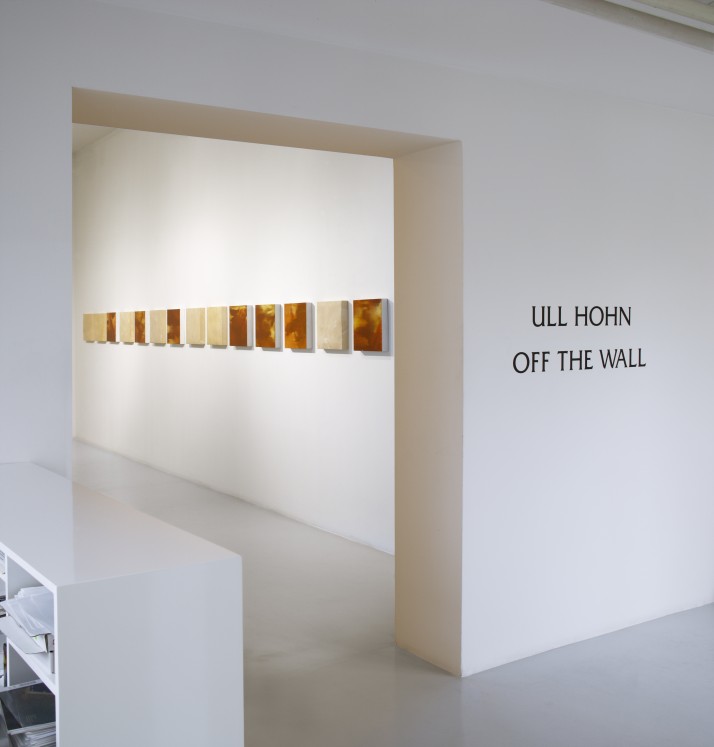Ull Hohn Off The Wall
A story of complex objects with a rather sensual surface quality
It is now important to provide some historical context, not only because the exhibition, “Off the Wall” is the reconstruction of another of the same name that occurred in 1995: As Ull Hohn left Düsseldorf in 1986 to further his studies in New York, he was immediately confronted with extensive new demands with the materialist-based theoretical discourse at the Whitney Program. Theory, in this case, didn’t necessarily imply underlining and subsequent application of every sentence from all the texts of the time. It did, however, mean subjecting one’s own artistic production to a certain set of premises and to approach it as continual intellectual labour. Formulations like “the artist/author is dead”, didn’t literally mean that the artist/author was dead or that the subject was non-existent. They suggest however the parting from idealistic conceptions, i.e. "subject" was seen as a conditioned and contextual dimension, which still played a role in the most intimate of desires (being that of becoming an artist). The separation of the artwork and production subject and the demands of social relevance were not a product of the 1970s or the sole result of a poststructuralist-based discourse. Poststructuralism did, however, do much for the popularization of such positions as the extensive politicization of the notion of art production. For a start, in this framework, politicization meant opening artistic production into the social sphere and acknowledgment of the differentiations, as they were introduced for instance by Marxist economics, linguistics or psychoanalysis.
Ull Hohn, who was always quick to take on outside demands and process each into their own “good object”, now faced the problem that he saw his past production was seen as inadequate and needed to find a new foothold. Paradoxically it also meant that he had to bring himself as sexual and class-conditioned subject into the picture. How do these demands of the subjectivization then manifest themselves in painting? With the series from 1988, Hohn tried to find the an answer. Initially, the images of erect penises, based on photographs painted on small, square wooden boxes seem rather spectacular. Under closer scrutiny and with consideration of the fact that Hohn took these penis photographs himself (using his then partner as a model), this impression is momentarily flipped. It then becomes apparent that these works are not dealing with (found, pornographic) images in the appropriation style of Gerhard Richter, but rather that one is standing in front of a work influenced more by a feminist mode of self-representation – which moreover plays with the implications of masculinity in that it mixes the notions around the lacanian conception of the phallus with a private pornographic representation of homosexual desire.
This complexity of the image is not exhausted in the thematic aspect, but has also a painterly complement. Here Hohn adopted the so-called wash-technique and its allegedly inexpressive gesturing made famous by Gerhard Richter. What seems like a respectful nod, is in reality a harsh critique of Richter’s objectivist positioning and its principles of purity and dissociation. Hohn’s paintings do profit from their impressive visual possibilities, they extend their radius with precisely those aspects that Richter and the Postwar Modernism were particularly resistant to: the sexual composition of the subject and gender specificity that informs all statements.
As this part of “Off the Wall” is a discussion about “content”, something that until then had not played an important role in Ull Hohn’s work, the second element of this series moves towards a completely different category of representation. The representation of skin is something that has proved an illusionist challenge for painters of all centuries. In the seven skin-coloured monochrome images, the painting itself becomes skin. The skinlike paint becomes an imitation of a bodily reality.
As categorically disparate the two elements of “Off The Wall” may be, a further discourse develops with their configuration together on the wall. It is not a coincidence that the fourteen pieces of this series are small, square boxes. Using the vocabulary implications of Minimalism (uniformity, presence, theatricality, specificity), Hohn assumes a similar interest in the criticism of perceptual conditions. The seriality brings a mechanical element to the work and thereby rebuffs all implications of composition and labourcraft. The crate-like dimensionality dominates the image and the series qualifies the individual crate objects.
In this series, Hohn also broached the discussion that was being led in the 1980’s with the intention to attribute a new postmodern, institution-critical identity to Minimalism. In its reading, however, Minimalism remains only one of the homogenizing forms of Modernism, and therefore Hohn extracted that which on the one hand served for the annulment of his own painting, and even the maelstrom of fundamental criticism on the other.
Meanwhile, such institution and art critical aspects have either worn themselves out or become the norm. That does not apply, however, to the kind of tension contained here in the autobiographical, art historical and technical elements. History is not a reconstruction of former constellations. Works of art are as documents only in the assessment of importance, how the documented is opened and currently utilizable. In this case, the presence of the beauty in complexity is a possible opening.
Manfred Hermes
Ull Hohn
Off the Wall
20.03.2006 – 22.04.2006
